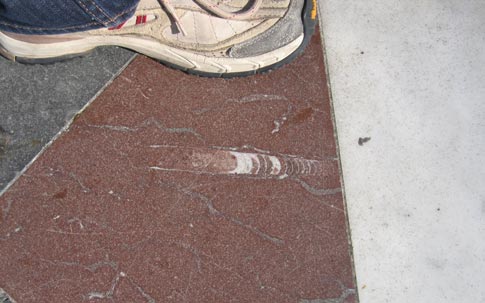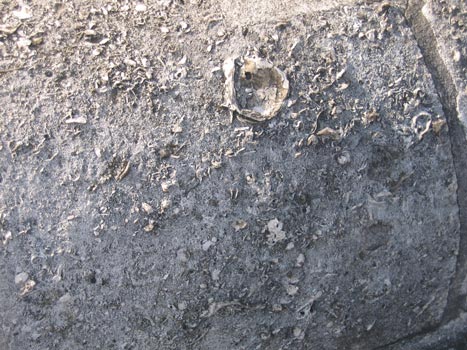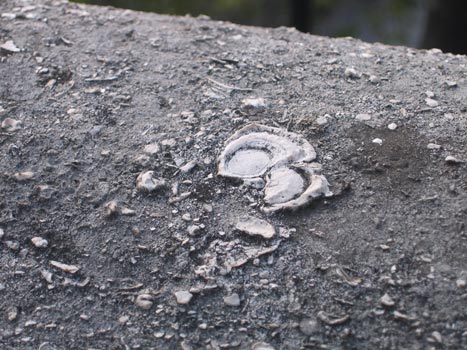Fossils are Abundant in London – If you Know Where to Look
When asked where to go fossil hunting many people advise a trip to the seaside to explore cliffs or perhaps a trip to a local quarry to study the sediment being exposed, but ironically if you know what to look for and where to look, a trip to a big city can yield a surprising number of exciting fossil discoveries. For example, you can go fossil hunting in London.
Fossil Hunting in London
A visit to London is no exception. This city may not be the obvious choice for a person to go fossil hunting but amongst the paved streets and buildings, an observant palaeontologist can find some remarkable evidence of ancient life. London itself, has yielded many important fossil discoveries the London clay preserves a sub-tropical, estuarine environment recording a rich diversity of life including crocodiles, turtles, birds, mammals and a number of plant fossils from a time after the extinction of the dinosaurs. The fossilised bones of Pleistocene lions and hippos have been discovered by workmen digging under Trafalgar Square, but you don’t need to excavate or even to carry a geological hammer to find fossils in a place like London. All you need are a sharp pair of eyes and a camera to record your discoveries.
Fossils at St Paul’s Cathedral
Take a visit to St Paul’s Cathedral for example. Whilst visitors are admiring the dome and the beautiful facia of the cathedral designed by Sir Christopher Wren, take a moment to examine the steps that lead up to the main entrance. The polished flagstones that can be found at the top of the steps leading up to the main thoroughfare contain a number of very well-preserved specimens of ancient cephalopods. The stone for these flags came from Sweden. They represent marine strata laid down something like 480 million years ago in the Early Ordovician geological period (Tremadocian faunal stage). Preserved as fossils in these stones are the remains of straight-shelled nautiloids. Nautiloids were actively swimming creatures distantly related to octopi and squid that lived in straight-chambered shells. Some of these creatures evolved into huge predators, the first sea monsters that ever lived, with genera such as Cameroceras and Endoceras reaching lengths approaching ten metres. These animals are only distantly related to the modern Nautilus but they had basically the same body plan. Their long conical shells were divided internally into many chambers, these were joined by a long tube that was used to control the amount of water in each of the chambers (siphuncle). The largest, end chamber housed the actual animal with its head, powerful beak and grasping tentacles.
Ordovician Nautiloids at St Paul’s Cathedral
Picture credit: Everything Dinosaur (Geologist provides foot for scale)
The fossils seen on the steps of St Paul’s do not represent huge specimens but the individual chambers (septa) of the shells can be clearly made out as the specimens are viewed in cross-section. Some of these fossils are more than thirty centimetres in length.
Portland Stone
Much of the stone used to build the Cathedral is Portland stone. This limestone, quarried from Portland in Dorset, was formed in a shallow, tropical Jurassic sea towards the end of this geological period (Tithonian faunal stage). This type of stone adorns many of the well-known public buildings of London. The white/grey limestone has been used as a building material in the United Kingdom since Roman times. The splendid Guildhall of London, built in the fifteenth Century, is one such building and a careful examination of the stone blocks that make up the facia of the building opening out into the main courtyard, can yield some fossil finds for an observant palaeontologist. The internal moulds of gastropods (snails), their argonite shells long dissolved away have been preserved, these are known as “Portland screws” as they are locally abundant in Portland limestone. Alongside the gastropods the moulds and casts of bivalves and other invertebrate creatures can be clearly made out. Many tourists visit the Guildhall to admire the galleries and the treasures they contain, but to a keen fossil hunter, there are 150 million year old treasures to be found in the stones that make up the building itself.
Evidence of Jurassic Invertebrates at the Guildhall
Picture credit: Everything Dinosaur
Cross the river Thames using Waterloo Bridge and take a little time to examine the coping stones that make up the supports to the pedestrian railings. This bridge may be used by thousands of commuters and tourists each day, but how many of them stop to look carefully at the building stones on the side of the walkways. These stones are also limestone, but they are not Portland stone. However, they do contain fossil evidence of a catastrophe that devastated a marine environment during the age of the dinosaurs. The limestone material represents Upper Jurassic strata and a close examination will reveal that it is packed with hundreds of fossils of marine invertebrates, all smashed up and jumbled together. This sediment has preserved the devastation caused by a major storm event such as a tsunami that destroyed a marine ecosystem. This habitat was probably close to shore and the shallow seascape took the fall force of huge natural disaster such as a hurricane or a tsunami. The remains of bivales such as oysters can be clearly seen, the shells mostly a bleached white against the grey limestone matrix. The remains of the calcite skeletons secreted by coralline algae can be made out as well, evidence of the destruction of a marine ecosystem preserved in the walls of a famous London landmark.
Fossils Preserved in the Limestone Used to Build Waterloo Bridge
Picture credit: Everything Dinosaur
It is not just London where such fossils can be found, many forms of sedimentary rock are used as building materials and with a keen eye fossils that record evidence of ancient life can be found at the very heart of big cities and towns.
For replicas of iconic fossil animals: Models of Iconic Fossil Animals.
You don’t need to go to a quarry or the seaside to go fossil hunting, next time you are in a big city take a close look at the stone building materials that are around you, or that you are walking on. After all, most of these hidden treasures go unnoticed by the thousands of people who walk by them every day.
More Fossils found on Waterloo Bridge
Picture credit: Everything Dinosaur










Hello I find old fossil